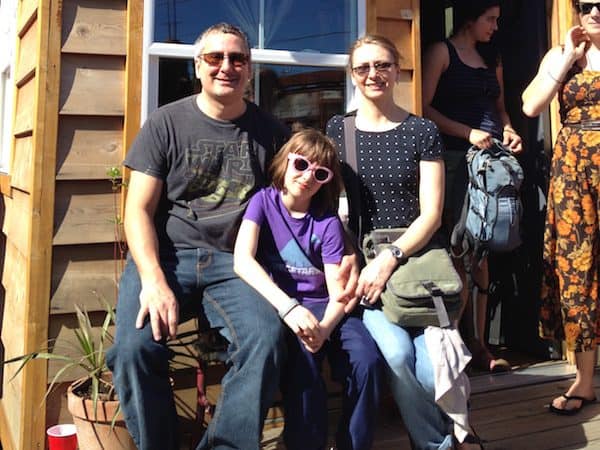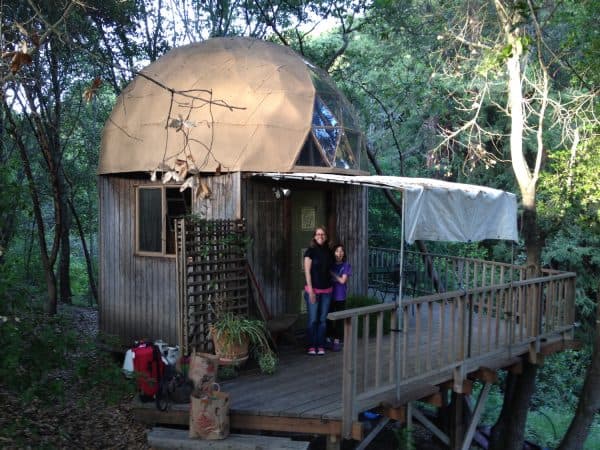Sociology professor Tracey Harris was given the opportunity to try ‘tiny house’ living. Here, she tells of her family's adventure of living with less
The tiny house movement is pretty self-explanatory; people downsize their homes in the name of sustainability. But if you’ve ever seen pictures of these tiny homes, you might wonder just how practical it is to live in one – I certainly did. So last spring, my family and I embarked on a tiny house adventure that had us live in five of these houses across two US states over a period of four weeks.
The houses ranged in size from 220-500 square feet, and varied in terms of amenities and sleeping arrangements. Some were on concrete pads, one was on wheels, and one was floating on a river. What they had in common was that each qualified as a tiny house for three residents and gave us a glimpse of abbreviated living. During the trip I kept a journal and we documented what became affectionately known as our ‘big and tiny adventure’ with a video diary.
This opportunity allowed us to see first-hand what it might be like to reduce our housing footprint and it made very clear for us what we actually needed to be happy; tiny house living was an important reminder of simplified life.
Tiny house living was an important reminder of simplified life
We pared down to only the essentials, sharing one suitcase on this 34-day trip. We each had three outfits, as well as a bathing suit, pyjamas and a raincoat. My daughter took a snuggly, her favourite book, and a couple of little toys that fit into her pint-sized backpack. I can honestly say that I didn’t miss a single thing and I actually found myself feeling irritated by the amount of stuff I had to unpack at each of our tiny house rentals.

Tracey with her husband and daughter outside one of the tiny houses they stayed in as part of her research adventure
Without surplus stuff to clean, sort, recycle, give away or eventually throw out, we ended up having, as I noted in my diary, “a trip that was about having new experiences, rather than acquiring stuff”. We went on more hikes than I can remember, visited many museums and places of learning and inspiration. We talked to so many people. The trip focused on adventure rather than accumulation. I learned that I need my family, friends, and my companion animals. I need contact with inspiring people and places, taking part in meaningful work, and spending time in nature. I learned that the size of my home or the stuff that I fill it with do not define me as a person or make me feel complete.
Less stuff and space meant that focusing was much easier in a tiny house – whether it was my daughter doing her homework, us grown-ups reading, or me writing an article. I felt as though all of the cobwebs in my brain had been swept away and I was left with this additional space to fill with knowledge, experiences, and ideas.
Tiny house living also changed the way we communicate with each other. We talked more in one month than we probably do over three or four months in our non-tiny house. Improved communication is something I can thank our tiny house experience for.
I felt as though all of the cobwebs in my brain had been swept away and I was left with this additional space to fill with knowledge, experiences and ideas
We learned what we actually need in order to have meaningful lives. This might sound obvious but there are a lot of things that people in wealthy nations are socialised to believe they need. Surprisingly for us, most of these things became completely unnecessary to our wellbeing. I found myself wondering how different our lives might have been if we had taken this much care before buying our home and especially before buying all of the stuff we put in it.
Why did we feel the need to furnish every room straight away, even if that meant that we ended up buying something that we didn’t necessarily love, only to consider replacing it when we had more time and money? This cycle of stuff is common in consumer-based countries and leads to overconsumption, overspending, and so much environmental waste.

Tracey with her daughter
So if it was so blissful in a tiny house, why aren’t we living in one permanently? This is a valid question. When we first returned home I desperately wanted to put a ‘for sale’ sign on the front lawn. I did struggle when we returned. Even though we still lived together I missed my partner and daughter, being with them, in the same room, within sightline, all of the time.
But we decided, as a family, to stay in our current home for now. We love our neighbourhood and the neighbours that we are happy to call our friends. Our daughter loves her school. But, we continue to talk about tiny house living, and continue to actively downsize our stuff, trying to be more mindful of our consumptive choices, as we slowly move towards the plan that will have us one day living in a tiny house for good.
Tracey Harris is assistant professor of sociology at Cape Breton University in Nova Scotia, Canada. This work was supported by a research policy grant from the university.
Images: Tracey Harris